Alaska’s Long Summer Days Boost Wildflower Blooms
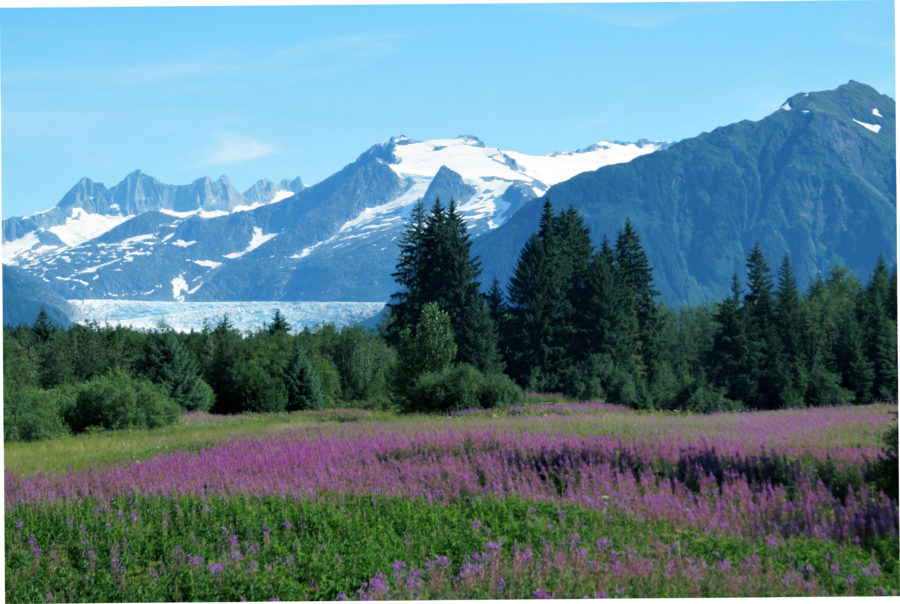
Many visitors travel to Juneau with the hope, and often the expectation, of seeing glaciers, bears, whales and salmon. We often experience these wonders on our Alaska Whales and Rainforest Trails and Photo Safari excursions. However, not expected, but surprisingly savored by our guests, are the enchanting wildflowers that punctuate the endless green landscape of Alaska’s Tongass National Forest. The Tongass is part of the largest temperate rainforest in the world, a swath of biomass that stretches from Northern California into the Kodiak Archipelago of Southcentral Alaska.
Although the springtime adage, “April showers bring May flowers” may be the case in much of North America, this observation is not true in Juneau. Indeed, Juneau receives profuse precipitation, but April temperatures are hardly spring-like, ranging only between 35°F to 49°F degrees (2°C to 10°C). May temperatures historically range between, 42°F to 57°F degrees (6°C to 14°C), also low compared to more southerly regions. Therefore, I believe it is not rain, but daylight that triggers the spring eruption of wild flowers across the Tongass National Forest in late May through summer. By June, Juneauites are experiencing about 17 to 18 hours per day of daylight; daylight that spurs wildflowers to spring forth.
While June offers a cornucopia of wildflower blooms, one can enjoy a rainbow of wildflower colors into early fall, whether it is the petite presence of a forget-me-not in June or the mesmerizing magenta of our fireweed fields in August.
“Flowers are the music of the ground from Earth’s lips, spoken without a sound.”
— from “Flowers”, a poem by Edwin Curran
Forget-Me-Not
Photo by Aleta Walther © 2018
 The petite, yellow-eyed forget-me-not is the Alaska State Flower. It grows well throughout Alaska and belongs to one of the few plant families that display true-blue flowers. Alaska’s Territorial Legislature approved the forget-me-not as the official flower of the Alaska Territory and the Governor signed the legislation into law on April 28, 1917. It was reaffirmed at the state flower when Alaska was granted statehood in 1959 “…because it is thought to be a flower of constancy and perseverance; traits which perfectly characterized Alaska’s first intrepid pioneers,” — www.ereferencedesk.com/resources/state-flower/alaska.html
The petite, yellow-eyed forget-me-not is the Alaska State Flower. It grows well throughout Alaska and belongs to one of the few plant families that display true-blue flowers. Alaska’s Territorial Legislature approved the forget-me-not as the official flower of the Alaska Territory and the Governor signed the legislation into law on April 28, 1917. It was reaffirmed at the state flower when Alaska was granted statehood in 1959 “…because it is thought to be a flower of constancy and perseverance; traits which perfectly characterized Alaska’s first intrepid pioneers,” — www.ereferencedesk.com/resources/state-flower/alaska.html
Fireweed and Dwarf Fireweed
Photos by Aleta Walther © 2018
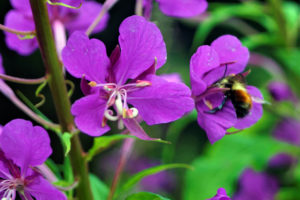 This wildly popular native is a staple in many Alaskan gardens and kitchens. Fireweed flower buds make a flavorful jelly and honey and its flower petals, a tasty tea. Gastineau Guiding’s Mt. Roberts Nature Center sells fireweed tea, honey and jelly. We see this brilliant beauty throughout Juneau in mid-to late summer, whether in a roadside meadow or at its most iconic Juneau location, Brotherhood Bridge Park. Fireweed flowers seed distribution resembles cottonwood “snow” floating on a coastal breeze. Alaskan’s say, “When fireweed turns to cotton, summer is soon forgotten”, meaning, winter weather is 6 to 8 weeks away.
This wildly popular native is a staple in many Alaskan gardens and kitchens. Fireweed flower buds make a flavorful jelly and honey and its flower petals, a tasty tea. Gastineau Guiding’s Mt. Roberts Nature Center sells fireweed tea, honey and jelly. We see this brilliant beauty throughout Juneau in mid-to late summer, whether in a roadside meadow or at its most iconic Juneau location, Brotherhood Bridge Park. Fireweed flowers seed distribution resembles cottonwood “snow” floating on a coastal breeze. Alaskan’s say, “When fireweed turns to cotton, summer is soon forgotten”, meaning, winter weather is 6 to 8 weeks away.
Rose Root or Stone Ledgecrop
Photo by Scott Ranger © 2015
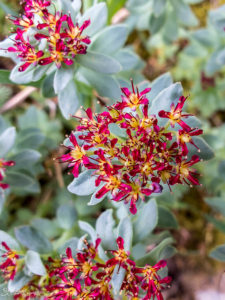 “If the root is dug up (please don’t!) and crushed, it has the scent of roses and gives it the genus name which means “of roses’,” says Gastineau Guiding veteran guide Scott Ranger. Rose root’s leaves are high in vitamin A and C and young tender leaves are a colorful addition in salads, soups and casseroles. This charming, but elusive beauty is a joy to see while rambling with guests during Gastineau Guiding’s Town, Tram and Timberline Trek excursion.
“If the root is dug up (please don’t!) and crushed, it has the scent of roses and gives it the genus name which means “of roses’,” says Gastineau Guiding veteran guide Scott Ranger. Rose root’s leaves are high in vitamin A and C and young tender leaves are a colorful addition in salads, soups and casseroles. This charming, but elusive beauty is a joy to see while rambling with guests during Gastineau Guiding’s Town, Tram and Timberline Trek excursion.
Siberian Miner’s-Lettuce or Siberian Springbeauty
Photo by Scott Ranger © 2015
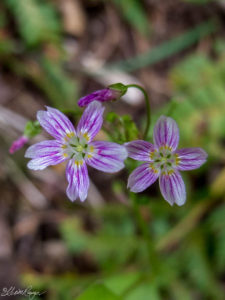 When the gold miners arrived from their sea journey to Alaska, many were beginning to suffer from scurvy. Those who came before, told miners to eat this plant and are responsible for its common name. Quite tasty and juicy, Siberian Miner’s-Lettuce offers abundant vitamin C to stave off the symptoms of this nasty disease. The leaves, stems, and flowers may all be eaten. All parts are high in vitamins A & C. We encounter this miniscule jewel during our Town, Tram and Timberline Trek excursion on Mt. Roberts.
When the gold miners arrived from their sea journey to Alaska, many were beginning to suffer from scurvy. Those who came before, told miners to eat this plant and are responsible for its common name. Quite tasty and juicy, Siberian Miner’s-Lettuce offers abundant vitamin C to stave off the symptoms of this nasty disease. The leaves, stems, and flowers may all be eaten. All parts are high in vitamins A & C. We encounter this miniscule jewel during our Town, Tram and Timberline Trek excursion on Mt. Roberts.
Woolly Geranium aka Northern Geranium
Photo by Annette Smith © 2015
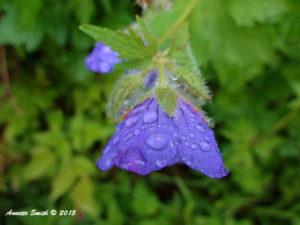 This perennial has several common names, but Alaskans refer to it as a northern geranium. This pink to purple flower is edible and has several medicinal and cosmetic uses, including root tea for stomach ulcers, diarrhea and dysentery. This colorful gem carpets the alpine meadow on the lower reaches of Mt. Roberts and we encounter its loveliness during our Town, Tram and Timberline Trek excursion.
This perennial has several common names, but Alaskans refer to it as a northern geranium. This pink to purple flower is edible and has several medicinal and cosmetic uses, including root tea for stomach ulcers, diarrhea and dysentery. This colorful gem carpets the alpine meadow on the lower reaches of Mt. Roberts and we encounter its loveliness during our Town, Tram and Timberline Trek excursion.
Dandelion
Photos by Aleta Walther © 2019
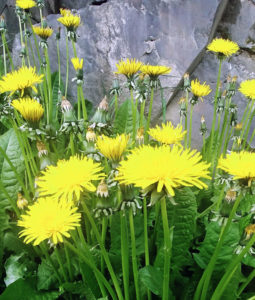 One gardener’s weed is another gardener’s flower. This adaptable plant is found across North America. These showy “flowers” offer some of the first abundant spring color in Southeast Alaska. All parts of the dandelion are edible and many Alaskan harvest dandelion leaves for salads and the flowers for wine and jellies. Full of antioxidants, Dandelion greens are eaten raw, steamed, boiled, sautéed or braised. Dandelions are a spring delicacy for black bears.
One gardener’s weed is another gardener’s flower. This adaptable plant is found across North America. These showy “flowers” offer some of the first abundant spring color in Southeast Alaska. All parts of the dandelion are edible and many Alaskan harvest dandelion leaves for salads and the flowers for wine and jellies. Full of antioxidants, Dandelion greens are eaten raw, steamed, boiled, sautéed or braised. Dandelions are a spring delicacy for black bears.
Wild Rose
Photo by Aleta Walther © 2018
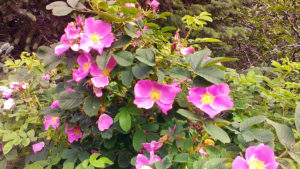 Most of this showy magenta native is edible. Its hips are high in vitamin C and are made into jams, jellies, syrups and teas. In early summer, the petals add a pinch of ruddy color and flavor to salads and sandwich spreads. Steep the petals for a relaxing tea. Candied rose hips are a yummy snack and also an ingredient added to cookies, puddings and cakes. Gastineau Guiding’s Mt. Roberts Nature Center serves wild rose hip tea to guests on its Town, Tram and Timberline Trek excursion.
Most of this showy magenta native is edible. Its hips are high in vitamin C and are made into jams, jellies, syrups and teas. In early summer, the petals add a pinch of ruddy color and flavor to salads and sandwich spreads. Steep the petals for a relaxing tea. Candied rose hips are a yummy snack and also an ingredient added to cookies, puddings and cakes. Gastineau Guiding’s Mt. Roberts Nature Center serves wild rose hip tea to guests on its Town, Tram and Timberline Trek excursion.
Western Skunk Cabbage
Photo by Aleta Walther © 2019
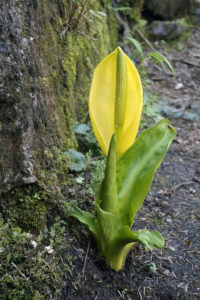 While not a true flower, the skunk cabbage is unusual and colorful to behold. The “flower” or seed dispersing spike of the skunk cabbage sprouts in early spring and resembles an ear of corn. This stinker’s name stems from the pungent aroma it emits to attract pollenating insects. Our black bears love to eat the roots, particularly in the spring when food is sparse. This hard-to-miss plant is plentiful on our Douglas Island Alaska’s, Whales and Rainforest Trails excursion. Juneauites like to say, “When skunk cabbage raises it head, bears soon leave their beds.”
While not a true flower, the skunk cabbage is unusual and colorful to behold. The “flower” or seed dispersing spike of the skunk cabbage sprouts in early spring and resembles an ear of corn. This stinker’s name stems from the pungent aroma it emits to attract pollenating insects. Our black bears love to eat the roots, particularly in the spring when food is sparse. This hard-to-miss plant is plentiful on our Douglas Island Alaska’s, Whales and Rainforest Trails excursion. Juneauites like to say, “When skunk cabbage raises it head, bears soon leave their beds.”
Nootka Lupine
Photo by Aleta Walther © 2019
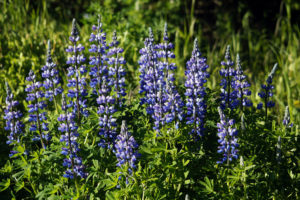 A spring photo favorite among Juneau visitors, this blue to purple pea species grows throughout Juneau. Considered too toxic for humans consumption, the nootka lupine is important to our forest. A pioneer plant, nootka lupines grow profusely in nutrient poor soil. It is a nitrogen-fixing plant and improves soil for the benefit of other vegetation. We can’t overlook this lovely during the early spring and encounter it on each of our excursions.
A spring photo favorite among Juneau visitors, this blue to purple pea species grows throughout Juneau. Considered too toxic for humans consumption, the nootka lupine is important to our forest. A pioneer plant, nootka lupines grow profusely in nutrient poor soil. It is a nitrogen-fixing plant and improves soil for the benefit of other vegetation. We can’t overlook this lovely during the early spring and encounter it on each of our excursions.
References
Wildflowers of the National Forests of Alaska: https://www.fs.usda.gov
United States Department of Agriculture (USDA): https://plants.sc.egov.usda.gov/java
https://www.alaska.org
www.ereferencedesk.com
Familiar Plants of Coastal Alaska, Stephen MacLean, Greatland Graphics, 2010
Discovering Wild Plants, Alaska, Western Canada, The Northwest, Janice J. Schofield, Eaton 2014
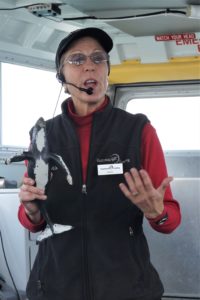 About the Author: 2019 is Aleta Walther’s fifth season sharing the history, mystery and magnificence of Southeast Alaska with our excursion guests. A veteran news journalist, freelance writer and photographer, nature interpreter and environmental educator, Aleta is perpetually slack-jawed by the awe of Alaska.
About the Author: 2019 is Aleta Walther’s fifth season sharing the history, mystery and magnificence of Southeast Alaska with our excursion guests. A veteran news journalist, freelance writer and photographer, nature interpreter and environmental educator, Aleta is perpetually slack-jawed by the awe of Alaska.

